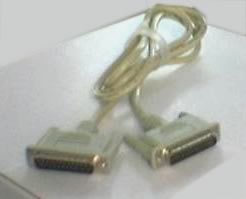How to set up a direct cable connection (DCC) in Windows XP?
Overview
 Null modem cable is an RS-232C cable that is designed to
connect two computers located in close proximity (up to about 15
meters) directly via serial (COM) ports, without modems and telephone line.
DirectParallel cable of Parallel
Technologies or compatible parallel transfer cable is a cable for connecting two computers located
in close proximity (up to about 3 meters, can be extended up to
more than 30 meters) directly via parallel (LPT) ports. Null modem cable is an RS-232C cable that is designed to
connect two computers located in close proximity (up to about 15
meters) directly via serial (COM) ports, without modems and telephone line.
DirectParallel cable of Parallel
Technologies or compatible parallel transfer cable is a cable for connecting two computers located
in close proximity (up to about 3 meters, can be extended up to
more than 30 meters) directly via parallel (LPT) ports.
This connection type can be used by a computer (desktop PC or
laptop) to access a network via another computer. The network
setup requires one
computer to be configured as a host and the second computer as a
guest. The host is the computer that has the resources to be shared,
while
the guest is the computer that needs to access the shared
resources.
Direct connection using DirectParallel cable is used more often because
it is faster (up to 4 Mbps) than null modem cable (less than 115 kbps).
What should I prepare?

Picture: Diagram of serial and parallel ports.
Serial port with DB-9 or DB-25 male connector.
Parallel port with DB-25 female connector.
1. Make sure your computers have serial or parallel ports.
Serial port is a 9-pin (DB-9) or 25-pin (DB-25) male connector (i.e. the
one that has pins).
Parallel port is a 25-pin (DB-25) female connector (i.e. the one that
has receptacles or holes).
Serial and parallel ports are usually located on the back of a computer.
2. Attach the cable connectors to serial ports (if it is a null modem cable) or
parallel ports (if it is a DirectParallel cable) on both computers.
Step-by-step Instructions
1. Open the New Connection
Wizard, and then click Next.
2. In Network Connection Type, click "Set up an advanced
connection", and then click Next.
3. In Advanced Connection Options, click "Connect directly to
another computer", and then click Next,
4. In Host or Guest, click Host or Guest based on your computer
role, and then click Next.
5. Click Next, and then do one of the following:
- If this computer is a host, in Connection Device, select Direct Parallel (LPT1) or Communications Port (COM).
- If this computer is a guest, in Connection Name, enter your connection name. Click Next. In Select a device, select Direct Parallel (LPT1) or Communications Port (COM).
6. Click Next, and then do one of the following:
- If this computer is a host, in Users Permissions, follow the
directions to specify the users you will allow to connect.
- If this computer is a guest, in Connection Availability, select
Anyone's use or My use only.
7. Click Next, then Finish.
After finishing the setup, a connection icon (i.e. Incoming
Connections for the host, the connection name for the guest) will be
displayed on Network Connections folder. You can check or change
the properties of the connection by right-clicking this icon, and
then click Properties.
|